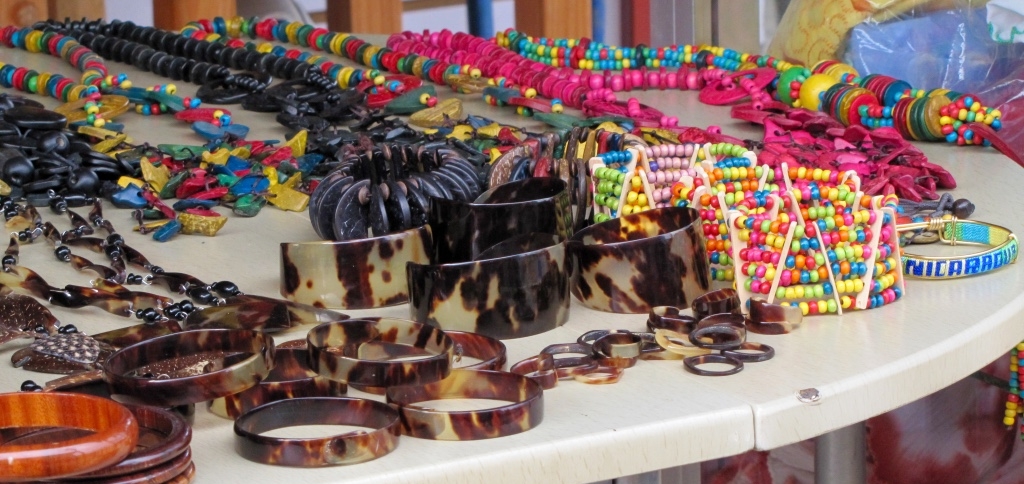Hawksbills Turtles Are Too Rare To Wear
One curse in working in wildlife conservation is that many of us after a while develop habits of searching out the threats to the animals we work to save all around us. With sea turtles, that includes finding plastic bags on the beach or watching people touch turtles while snorkeling. One habit I picked up years ago while working with leatherback turtles in Costa Rica was to look out for turtleshell jewelry whenever walking around the tourist town of Puerto Viejo.
So last summer when I found myself souvenir shopping with my daughter in the beach town of San Juan del Sur in Nicaragua, I ended up spending more time mentally cataloging the abundant turtleshell products for sale by the vendors and in the stores than actually looking for things to buy. I told my daughter that we wouldn’t be buying from anyone who sold those products and against my better judgment ended up arguing with a couple of the vendors about the legality of their actions (it is illegal to sell in Nicaragua but rarely enforced). After more than an hour, so many places sold turtleshell that my daughter begged me to just let her buy a braided bracelet anyway so we could stop shopping and go to the beach.
Turtleshell for sale in Nicaragua. Photo: Paula von Weller
Turtleshell (sometimes incorrectly called “tortoiseshell”) comes from the critically endangered hawksbill sea turtle. The beautiful color pattern of gold, amber, and brown (which helps them hide in coral reefs) combined with the ease of shaping the carapace (made of keratin) make this material popular for artisans, kind of like a natural plastic. The trade in the shells goes back thousands of years and was a multinational business for many years. Most of the shells were exported to Japan from around the world, where an entire industry of artisans made exquisite products out of the “bekko” as it’s called there, similar to the ivory carvers of China. Over a 50 year period, an estimated 2 million shells were shipped to Japan, which devastated hawksbill turtle populations around the world according to an excellent article in State of the World's Turtles (see graphic below).
Graphic from State Of The World's Turtles, Volume 3
Having worked with sea turtles my entire career, I knew this continued to be a problem but had no idea on how large of a scale the sale of turtleshell products currently is. Though the legal end of the international trade of their shells was finally outlawed as part of the Convention on International Trade of Endangered Species (CITES) in 1992, hawksbills have yet to recover their numbers. Estimates of the total number of adult female hawksbills worldwide range from only 15,000 – 20,000 (since the males don’t come ashore to nest, they are impossible to count) and they continue to be listed as critically endangered by the International Union for the Conservation of Nature.
Hawksbills are not just a pretty shell; they are critical to the health of coral reefs, sometimes referred to as the “engineers of the coral reef.” These turtles primarily eat sea sponges, which compete with corals for space. Without hawksbills around, the sponges can take over and crowd out the coral. Sea sponges can be toxic to some animals; hawksbills are one of their few predators and can eat an estimated 1,000 of them in a year.
These reptiles are also important for coastal economies and divers and snorkelers. Many people flock to tropical reefs around the world hoping to spot them gracefully swimming in search of food, bringing in billions of travel dollars and providing lifelong memories. Unfortunately it is also many of those travelers who, sometimes unknowingly, take a piece of these turtles home with them as souvenirs.
The good news is that travelers can be part of the solution and help end the demand for turtleshell products. Too Rare To Wear is a new campaign that SEE Turtles is helping to launch that is educating travelers about turtleshell and how to avoid it. We are encouraging people when souvenir shopping to not only but something different, but to avoid shopping anywhere that does sell it, and most importantly, letting the people selling these products why you won’t buy anything of theirs.
Learn more about this issue, read the guide to identifying turtleshell, and take the pledge to avoid it at TooRareToWear.org.
Cover photo by Julie Suess.


